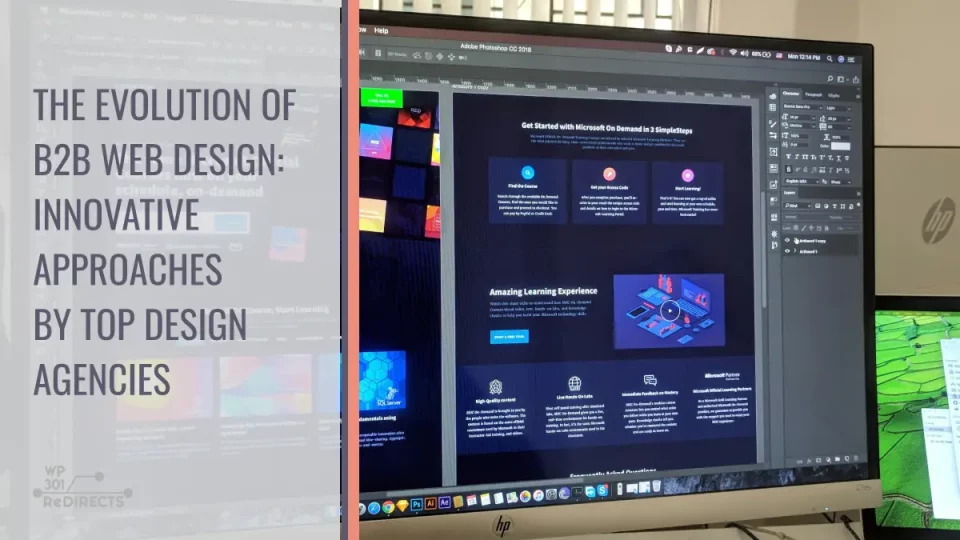The digital era has ushered in a transformative phase for B2B website design, primarily driven by the creative and strategic efforts of specialized agencies. These agencies have not only redefined the aesthetics of web design but have fundamentally altered the way businesses interact with their clients and stakeholders online. This evolution transcends mere visual appeal, delving into user experience, functionality, and digital storytelling. The journey of a B2B web design agency from its early stages to its current form reflects how top design agencies have adapted to and influenced the changing digital landscape.
Early Stages of B2B Web Design
In the late 1990s and early 2000s, the first iterations of B2B web design prioritized basic functionality over aesthetic sophistication. Websites functioned more like digital brochures, offering straightforward company information and contact details. The design approach was typically template-driven, offering limited scope for customization or strong brand representation. However, as internet technologies evolved, so did the need for more engaging and user-friendly design principles.
You can use professional service from reputed designs. With a forward-thinking approach to design and functionality, Cudedesign.co.uk ensures every B2B website is built to engage, convert, and grow with your business. You can check their details if you think.”
Shift Towards User-Centered Design
The mid-2000s marked a significant shift in B2B web design, pivoting towards a user-centered approach. This period saw design agencies placing a greater emphasis on the user experience (UX), tailoring websites to meet business clients’ unique needs and decision-making processes. Improved navigation systems, well-structured content, and strategically placed call-to-action buttons became standard features, guiding users more effectively through the site.
The Role of Responsive Design
The proliferation of mobile devices brought responsive design into sharp focus. When design is responsive, it not only improves user experience but also enhances the website’s loading speed across different devices. Faster loading times lead to higher user retention, reducing bounce rates and improving overall site performance, which is critical for maintaining user engagement and satisfaction Recognizing that B2B decision-makers were increasingly accessing content on various devices, top agencies adopted responsive web design techniques to ensure a consistent and seamless user experience across all platforms, thus enhancing overall accessibility and engagement.
Incorporating Interactive Elements
Further advancements in web technologies enabled agencies to integrate more interactive elements into B2B websites. Features like interactive infographics, animated product demos, and virtual tours made information consumption more engaging and allowed businesses to showcase their innovative edge. Some top sites also post a link and scannable QR code of their digital business card to connect and network with everyone who visits the site.
Emphasis on Storytelling and Branding
As storytelling became a pivotal aspect of digital marketing, B2B web design embraced this trend. Agencies started crafting websites that told compelling brand stories, effectively communicating a company’s values, mission, and vision. This narrative approach helped forge deeper emotional connections with users, differentiating brands in a competitive digital marketplace.
Integration of Advanced Technologies
In recent years, the incorporation of cutting-edge technologies such as artificial intelligence (AI), machine learning, and virtual reality (VR) has been a game-changer in B2B web design. AI-powered chatbots for real-time user assistance and personalized experiences have become increasingly common. VR offered a unique way for businesses to provide immersive product demonstrations, adding an exciting dimension to online interactions.
Advanced platforms like DeoVR have enabled businesses to create fully immersive virtual showrooms where clients can explore products and services in realistic 3D environments.
Data-Driven Design Decisions
The role of data analytics in shaping web design decisions grew exponentially. B2B website design agencies started to harness user data with the help of data analytics services providers to gain insights into behavior patterns, preferences, and challenges. This data-driven strategy led to creating more targeted and effective web designs, significantly enhancing the user experience.
Sustainable and Inclusive Design
The latest trends in B2B web design also include a focus on sustainability and inclusivity. Agencies are now more mindful of creating accessible websites to a diverse range of users, including those with disabilities. Sustainable web design practices aimed at reducing the digital carbon footprint have also gained importance.
The Future of B2B Web Design
As we look to the future, B2B web design is expected to evolve, becoming more dynamic and tailored to individual user needs. Emerging technologies like augmented reality (AR) and the Internet of Things (IoT) promise to open up new frontiers for user interaction and engagement. Personalization and context-aware experiences are likely to be at the forefront of future web design trends.
The journey of B2B web design, driven by innovative design agencies, highlights an exciting trajectory from static, informational websites to dynamic, user-centric platforms. As technology and user expectations continue to evolve, so will the strategies and creative solutions these agencies offer. The future of B2B web design promises more immersive, efficient, and impactful digital experiences tailor-made for the business world.
